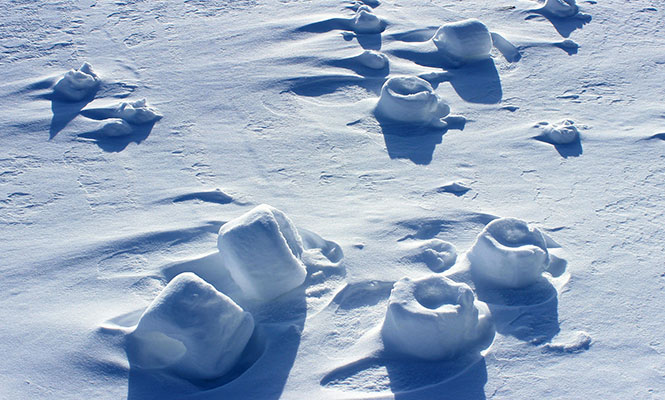The science behind snow rollers
Snow Rollers are a strange occurrence caused by freezing winds and untouched snow. Many of these can be found all around the Kent State campus.
February 6, 2014
A specific combination of weather elements create what meteorologists call snow rollers — a phenomenon that Kent has already seen once this winter and could see again with the right conditions.
“Snow rollers are a funny, whimsical winter thing,” geography department chair Tom Schmidlin said. “It’s almost as if gnomes rolled them or something.”
Schmidlin said in order for snow rollers to form, the balance of wet snow and high winds in a certain, constant direction must combine. The high winds pick up a surface layer of snow and roll it into a snowball-like formation. They are usually hollow in the center because the initial rollover is a hollow circle.
“We had about 6 inches of cold, powdery snow and overnight, the temperature went up,” Schmidlin said. “Then the arctic front came through with winds up to 40 mph. Therefore, a perfect combination for snow rollers.”
This phenomenon is not a new discovery. In Schmidlin’s research, he found a series of accounts in “Weather Monthly,” a national weather newsletter, dating back to December 1895.
“It says people noticed them by a railroad in Spokane, Washington,” Schmidlin said. “That’s the earliest account I could find, but I’m sure they’ve been around a long time.”
One account of snow rollers in Montana in 1899 recorded in the “Weather Monthly” newsletter read, “High wind began blowing that caused the moist snow on the ground to form large snowballs until the fields and pastures had looked like Mother Nature had been amusing herself on a large scale.”
Though they have been around a long time, Schmidlin said he has never known anyone that has seen them or seen them himself.
“I’ve never heard anyone state how often they occur,” he said. “It seems to be a rare-enough event. In reading about it, they seem to happen in a pretty small area. But this time, they seem to be more widespread. I’ve heard about them being in [the] West Virginia and Columbus areas. It seems like a pretty big area had snow rollers.”
Brian Ivey, senior journalism major and weather enthusiast, is excited that he got to see them in his lifetime.
“They are like little naturemade snowballs,” Ivey said. “We had some right outside [Franklin Hall]. I think it’s really cool because of how rare it is and all the different factors going into making them. They varied in sizes and they were all over Ohio. It’s really cool to think that no one has seen them before, even people who are 40 or 50 years old.”
According to Schmidlin, this is the coldest winter the Kent area has experienced since 2009, with temperatures dropping into the negatives and a large amount of snowfall.
Contact Haley Baker at [email protected].












